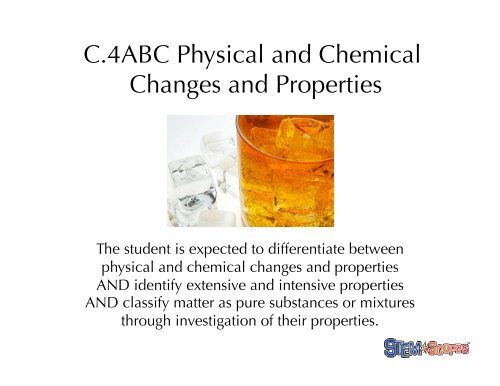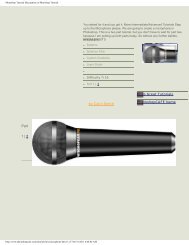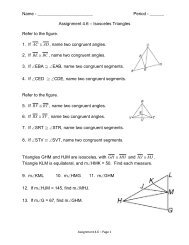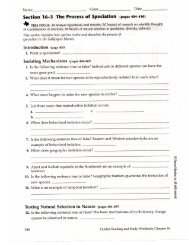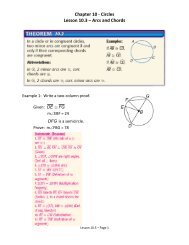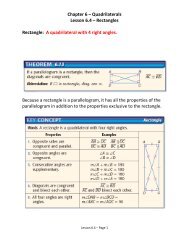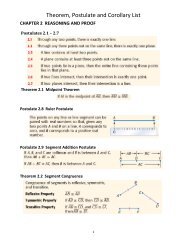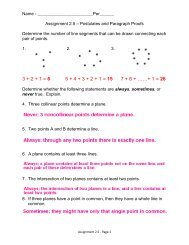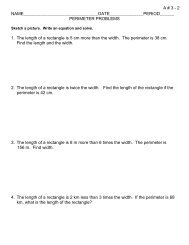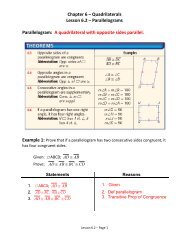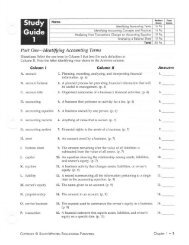C.4ABC Physical and Chemical Changes and Properties
C.4ABC Physical and Chemical Changes and Properties
C.4ABC Physical and Chemical Changes and Properties
You also want an ePaper? Increase the reach of your titles
YUMPU automatically turns print PDFs into web optimized ePapers that Google loves.
<strong>C.4ABC</strong> <strong>Physical</strong> <strong>and</strong> <strong>Chemical</strong><strong>Changes</strong> <strong>and</strong> <strong>Properties</strong>The student is expected to differentiate betweenphysical <strong>and</strong> chemical changes <strong>and</strong> propertiesAND identify extensive <strong>and</strong> intensive propertiesAND classify matter as pure substances or mixturesthrough investigation of their properties.
C.5AB The Periodic TableThe student is expected to explain the use of chemical <strong>and</strong> physicalproperties in the historical development of the Periodic Table ANDuse the Periodic Table to identify <strong>and</strong> explain the properties ofchemical families, including alkali metals, alkaline earth metals,halogens, noble gases, <strong>and</strong> transition metals.
C.5C Periodic TrendsThe student is expected to use the Periodic Tableto identify <strong>and</strong> explain periodic trends, including atomic<strong>and</strong> ionic radii, electronegativity, <strong>and</strong> ionization energy.
C.6A Atomic TheoryThe student is expected to underst<strong>and</strong> the experimentaldesign <strong>and</strong> conclusions used in the development ofmodern atomic theory, including Dalton's Postulates,Thomson's discovery of electron properties,Rutherford's nuclear atom, <strong>and</strong> Bohr's nuclear atom.
C.6BC Atomic EquationsThe student is expected to underst<strong>and</strong> the electromagneticspectrum <strong>and</strong> the mathematical relationships betweenenergy, frequency, <strong>and</strong> the wavelength of lightAND calculate the wavelength, frequency, <strong>and</strong> energy of lightusing Planck's constant <strong>and</strong> the speed of light.
C.6DE Atomic StructureThe student is expected to use isotopic composition tocalculate average atomic mass of an element AND expressthe arrangement of electrons in atoms through electronconfigurations <strong>and</strong> Lewis valence electron dot structures.
C.12ABC Nuclear ChemistryThe student is expected to describe the characteristics ofalpha, beta, <strong>and</strong> gamma radiation AND describe radioactivedecay process in terms of balanced nuclear equations ANDcompare fission <strong>and</strong> fusion reaction.
C.7AB <strong>Chemical</strong> FormulasThe student is expected to name ionic compounds containing main groupor transition metal, covalent compounds, acid, <strong>and</strong> bases, usingInternational Union of Pure <strong>and</strong> Applied Chemistry (IUPAC)nomenclature rules AND write the chemical formulas of commonpolyatomic ions, ionic compounds containing main group or transitionmetals, covalent compounds, acids, <strong>and</strong> bases AND construct electrondot formulas to illustrate ionic <strong>and</strong> covalent bonds.
C.7CD <strong>Chemical</strong> BondingThe student is expected to constructelectron dot formulas to illustrateionic <strong>and</strong> covalent bonds.
C.7E Molecular StructureThe student is expected to predict molecular structurefor molecules with linear, trigonal planar, ortetrahedral electron pair geometries usingValance Shell Electron Pair Repulsion (VSEPR) theory.
C.8AB The MoleThe student is expected to define <strong>and</strong> use theconcept of a mole AND use the mole concept tocalculate the number of atoms, ions, ormolecules in a sample of material.
C.8C Percent CompositionCalculationsThe student is expected to calculatepercent composition <strong>and</strong> empirical<strong>and</strong> molecular formulas.
C.8D <strong>Chemical</strong> EquationsThe student is expected to use thelaw of conservation of mass to write <strong>and</strong> balancechemical equations.
C.8E StoichiometryThe student is expected to performstoichiometric calculations, including determination ofmass relationships between reactants <strong>and</strong> products,calculation of limiting reagents, <strong>and</strong> percent yield.
C.9AC Gas LawsThe student is expected to describe <strong>and</strong> calculate therelations between volume, pressure, number of moles, <strong>and</strong>temperature for an ideal gas as described by Boyles's law,Charles' law, Avogadro's law, Dalton's law of partial pressure,<strong>and</strong> the ideal gas law AND describe the postulatesof kinetic molecular theory.
C.9B Gas StoichiometryThe student is expected to performstoichiometric calculations, including determinationof mass <strong>and</strong> volume relationships between reactants <strong>and</strong>products for reactions involving gases.
C.11AB EnergyThe student is expected to underst<strong>and</strong> energy <strong>and</strong>its forms, including kinetic, potential, chemical, <strong>and</strong>thermal energies AND underst<strong>and</strong> the law of conservationof energy <strong>and</strong> the processes of heat transfer.
C.11CD Thermochemical EquationsThe student is expected to use thermochemical equationsto calculate energy changes that occur in chemical reactions<strong>and</strong> classify reactions as exothermic or endothermicAND perform calculations involving heat, mass,temperature change, <strong>and</strong> specific heat.
C.11E CalorimetryThe student is expected to use calorimetryto calculate the heat of a chemical process.
C.10AB Aqueous SolutionsThe student is expected to describe the unique role of waterin chemical <strong>and</strong> biological systems AND develop <strong>and</strong>use general rules regarding solubility throughinvestigations with aqueous solutions.
C.10CD MolarityThe student is expected to calculate the concentration ofsolutions in units of molarity AND use molarity tocalculate the dilutions of solutions.
C.10EF Solutions <strong>and</strong> SolubilityThe student is expected to distinguish between types ofsolutions such as electrolytes <strong>and</strong> nonelectrolytes <strong>and</strong>unsaturated, saturated, <strong>and</strong> supersaturated solutions ANDinvestigate factors that influence solubilities <strong>and</strong> rates ofdissolution such as temperature, agitation, <strong>and</strong> surface area.
C.10GHIJ Acids <strong>and</strong> BasesThe student is expected to define acids <strong>and</strong> bases <strong>and</strong> distinguishbetween Arrhenius <strong>and</strong> Bronsted-Lowry definitions <strong>and</strong> predict productsin acid base reactions, precipitation reactions, <strong>and</strong> oxidation-reductionreactions AND underst<strong>and</strong> <strong>and</strong> differentiate among acid-base reactions,precipitation reactions, <strong>and</strong> oxidation-reduction reactionsAND define pH <strong>and</strong> use the hydrogen or hydroxide ions concentrations tocalculate the pH of a solution AND distinguish between degrees ofdissociation for strong <strong>and</strong> weak acids <strong>and</strong> bases.


